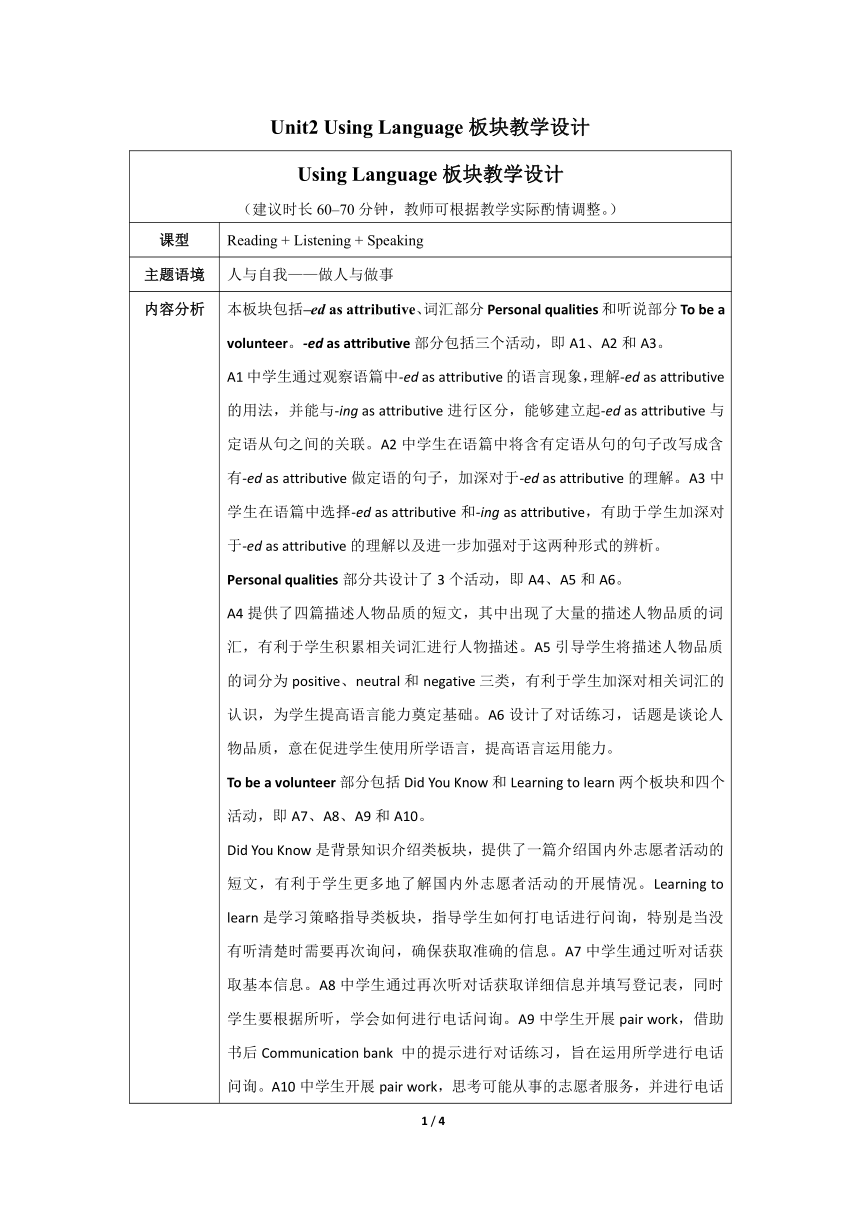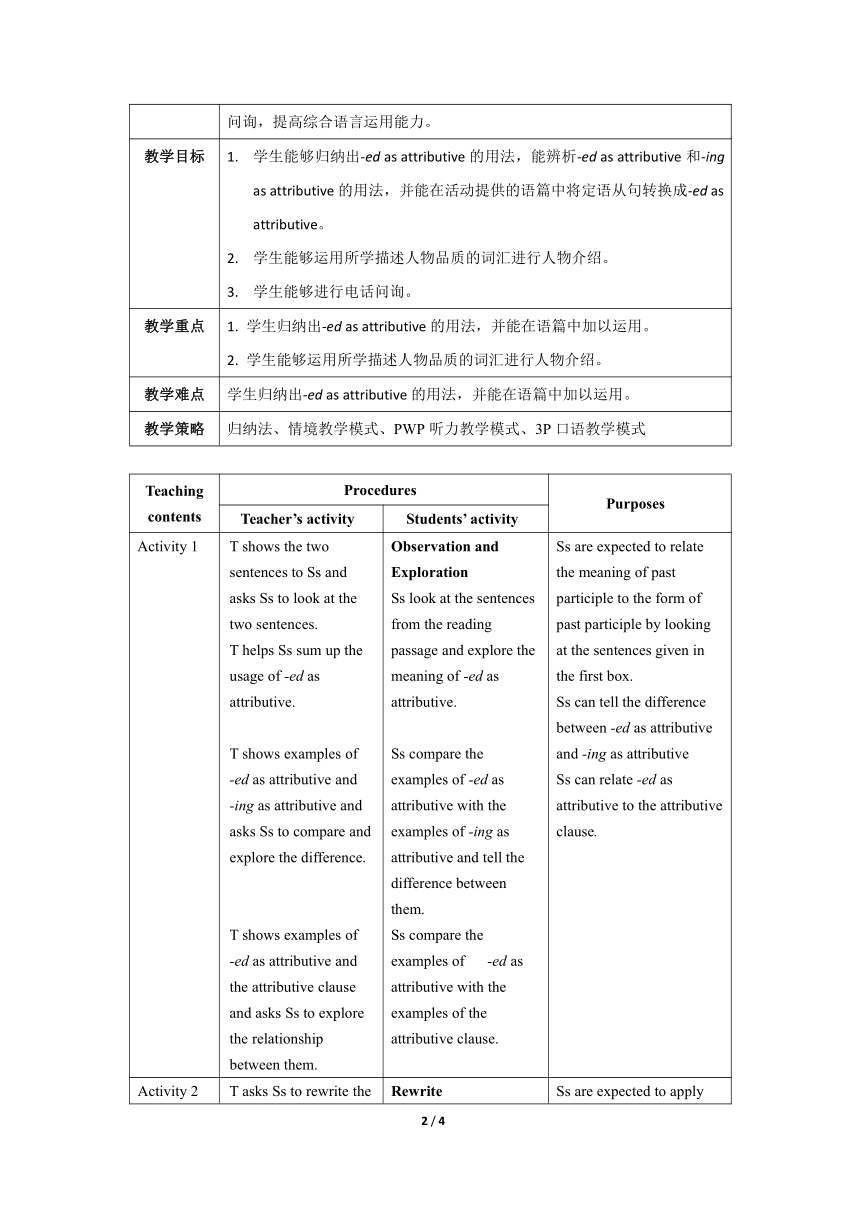外研版(2019)必修第三册 Unit2 Making a difference UsingLanguage板块教学设计
文档属性
| 名称 | 外研版(2019)必修第三册 Unit2 Making a difference UsingLanguage板块教学设计 |  | |
| 格式 | docx | ||
| 文件大小 | 26.7KB | ||
| 资源类型 | 教案 | ||
| 版本资源 | 外研版(2019) | ||
| 科目 | 英语 | ||
| 更新时间 | 2023-03-01 11:07:59 | ||
图片预览


文档简介
Unit2 Using Language板块教学设计
Using Language板块教学设计 (建议时长60–70分钟,教师可根据教学实际酌情调整。)
课型 Reading + Listening + Speaking
主题语境 人与自我——做人与做事
内容分析 本板块包括–ed as attributive、词汇部分Personal qualities和听说部分To be a volunteer。-ed as attributive部分包括三个活动,即A1、A2和A3。 A1中学生通过观察语篇中-ed as attributive的语言现象,理解-ed as attributive的用法,并能与-ing as attributive进行区分,能够建立起-ed as attributive与定语从句之间的关联。A2中学生在语篇中将含有定语从句的句子改写成含有-ed as attributive做定语的句子,加深对于-ed as attributive的理解。A3中学生在语篇中选择-ed as attributive和-ing as attributive,有助于学生加深对于-ed as attributive的理解以及进一步加强对于这两种形式的辨析。 Personal qualities部分共设计了3个活动,即A4、A5和A6。 A4提供了四篇描述人物品质的短文,其中出现了大量的描述人物品质的词汇,有利于学生积累相关词汇进行人物描述。A5引导学生将描述人物品质的词分为positive、neutral和negative三类,有利于学生加深对相关词汇的认识,为学生提高语言能力奠定基础。A6设计了对话练习,话题是谈论人物品质,意在促进学生使用所学语言,提高语言运用能力。 To be a volunteer部分包括Did You Know和Learning to learn两个板块和四个活动,即A7、A8、A9和A10。 Did You Know是背景知识介绍类板块,提供了一篇介绍国内外志愿者活动的短文,有利于学生更多地了解国内外志愿者活动的开展情况。Learning to learn是学习策略指导类板块,指导学生如何打电话进行问询,特别是当没有听清楚时需要再次询问,确保获取准确的信息。A7中学生通过听对话获取基本信息。A8中学生通过再次听对话获取详细信息并填写登记表,同时学生要根据所听,学会如何进行电话问询。A9中学生开展pair work,借助书后Communication bank 中的提示进行对话练习,旨在运用所学进行电话问询。A10中学生开展pair work,思考可能从事的志愿者服务,并进行电话问询,提高综合语言运用能力。
教学目标 学生能够归纳出-ed as attributive的用法,能辨析-ed as attributive和-ing as attributive的用法,并能在活动提供的语篇中将定语从句转换成-ed as attributive。 学生能够运用所学描述人物品质的词汇进行人物介绍。 学生能够进行电话问询。
教学重点 1. 学生归纳出-ed as attributive的用法,并能在语篇中加以运用。 2. 学生能够运用所学描述人物品质的词汇进行人物介绍。
教学难点 学生归纳出-ed as attributive的用法,并能在语篇中加以运用。
教学策略 归纳法、情境教学模式、PWP听力教学模式、3P口语教学模式
Teaching contents Procedures Purposes
Teacher’s activity Students’ activity
Activity 1 T shows the two sentences to Ss and asks Ss to look at the two sentences. T helps Ss sum up the usage of -ed as attributive. T shows examples of -ed as attributive and -ing as attributive and asks Ss to compare and explore the difference. T shows examples of -ed as attributive and the attributive clause and asks Ss to explore the relationship between them. Observation and Exploration Ss look at the sentences from the reading passage and explore the meaning of -ed as attributive. Ss compare the examples of -ed as attributive with the examples of -ing as attributive and tell the difference between them. Ss compare the examples of -ed as attributive with the examples of the attributive clause. Ss are expected to relate the meaning of past participle to the form of past participle by looking at the sentences given in the first box. Ss can tell the difference between -ed as attributive and -ing as attributive Ss can relate -ed as attributive to the attributive clause.
Activity 2 T asks Ss to rewrite the underlined sentences using the -ed form Rewrite Ss rewrite the underlined sentences using the -ed form. Ss are expected to apply what they have observed and explored.
Activity 3 T asks to read the passage and choose the correct form of the words. Choose the correct form of the words Ss read the passage and choose the correct form of the words. Ss are expected to state the difference between -ed as attributive and -ing as attributive and consolidate what they have learned.
Activity 4 T asks Ss to read the four descriptions, underline the words that describe personal qualities and add the underlined words to the form. T encourages Ss to add more words which describe personal qualities to the form. T encourages Ss to work in pairs to talk about people’s personal qualities using the words they have learned. Reading Ss read the four descriptions, underline the words that describe personal qualities and add the underlined words to the form. Ss add more words which describe personal qualities to the form. Ss work in pairs to talk about people’s personal qualities using the words they have learned. Ss can set up their vocabulary web about words which describe personal qualities. Ss are expected to enhance their ability to use the related words.
Activity 5 T asks Ss to read the short passage about volunteering in P19. T may give the following instruction: Since different people have different qualities, we can choose suitable volunteer work according to our qualities. T plays the tape about the phone enquiry and asks Ss to complete the activities 7-8 in P19. Reading and listening Ss read the short passage about volunteering in P19. Ss are guided to think more about voluntary work by T’s instruction. Then, Ss listen to the phone enquiry and complete the activities7-8 in P19 Ss know more about voluntary work and know how to make a phone enquiry about the topic.
Activity 6 T asks Ss to act out a telephone enquiry with the help of communication bank in P81 and P84. Speaking Ss act out a telephone enquiry with the help of communication bank in P81 and P84. Ss can apply what they have learned about to how to make phone enquiry according to the topic.
Activity 7 T encourages Ss to think about other voluntary work that Ss would like to be involved in, and have a similar conversation. Talking Ss think about other voluntary work that they would like to be involved in, and have a similar conversation. Ss can apply what Ss have learned to practice and are ready to be volunteers.
1 / 4
Using Language板块教学设计 (建议时长60–70分钟,教师可根据教学实际酌情调整。)
课型 Reading + Listening + Speaking
主题语境 人与自我——做人与做事
内容分析 本板块包括–ed as attributive、词汇部分Personal qualities和听说部分To be a volunteer。-ed as attributive部分包括三个活动,即A1、A2和A3。 A1中学生通过观察语篇中-ed as attributive的语言现象,理解-ed as attributive的用法,并能与-ing as attributive进行区分,能够建立起-ed as attributive与定语从句之间的关联。A2中学生在语篇中将含有定语从句的句子改写成含有-ed as attributive做定语的句子,加深对于-ed as attributive的理解。A3中学生在语篇中选择-ed as attributive和-ing as attributive,有助于学生加深对于-ed as attributive的理解以及进一步加强对于这两种形式的辨析。 Personal qualities部分共设计了3个活动,即A4、A5和A6。 A4提供了四篇描述人物品质的短文,其中出现了大量的描述人物品质的词汇,有利于学生积累相关词汇进行人物描述。A5引导学生将描述人物品质的词分为positive、neutral和negative三类,有利于学生加深对相关词汇的认识,为学生提高语言能力奠定基础。A6设计了对话练习,话题是谈论人物品质,意在促进学生使用所学语言,提高语言运用能力。 To be a volunteer部分包括Did You Know和Learning to learn两个板块和四个活动,即A7、A8、A9和A10。 Did You Know是背景知识介绍类板块,提供了一篇介绍国内外志愿者活动的短文,有利于学生更多地了解国内外志愿者活动的开展情况。Learning to learn是学习策略指导类板块,指导学生如何打电话进行问询,特别是当没有听清楚时需要再次询问,确保获取准确的信息。A7中学生通过听对话获取基本信息。A8中学生通过再次听对话获取详细信息并填写登记表,同时学生要根据所听,学会如何进行电话问询。A9中学生开展pair work,借助书后Communication bank 中的提示进行对话练习,旨在运用所学进行电话问询。A10中学生开展pair work,思考可能从事的志愿者服务,并进行电话问询,提高综合语言运用能力。
教学目标 学生能够归纳出-ed as attributive的用法,能辨析-ed as attributive和-ing as attributive的用法,并能在活动提供的语篇中将定语从句转换成-ed as attributive。 学生能够运用所学描述人物品质的词汇进行人物介绍。 学生能够进行电话问询。
教学重点 1. 学生归纳出-ed as attributive的用法,并能在语篇中加以运用。 2. 学生能够运用所学描述人物品质的词汇进行人物介绍。
教学难点 学生归纳出-ed as attributive的用法,并能在语篇中加以运用。
教学策略 归纳法、情境教学模式、PWP听力教学模式、3P口语教学模式
Teaching contents Procedures Purposes
Teacher’s activity Students’ activity
Activity 1 T shows the two sentences to Ss and asks Ss to look at the two sentences. T helps Ss sum up the usage of -ed as attributive. T shows examples of -ed as attributive and -ing as attributive and asks Ss to compare and explore the difference. T shows examples of -ed as attributive and the attributive clause and asks Ss to explore the relationship between them. Observation and Exploration Ss look at the sentences from the reading passage and explore the meaning of -ed as attributive. Ss compare the examples of -ed as attributive with the examples of -ing as attributive and tell the difference between them. Ss compare the examples of -ed as attributive with the examples of the attributive clause. Ss are expected to relate the meaning of past participle to the form of past participle by looking at the sentences given in the first box. Ss can tell the difference between -ed as attributive and -ing as attributive Ss can relate -ed as attributive to the attributive clause.
Activity 2 T asks Ss to rewrite the underlined sentences using the -ed form Rewrite Ss rewrite the underlined sentences using the -ed form. Ss are expected to apply what they have observed and explored.
Activity 3 T asks to read the passage and choose the correct form of the words. Choose the correct form of the words Ss read the passage and choose the correct form of the words. Ss are expected to state the difference between -ed as attributive and -ing as attributive and consolidate what they have learned.
Activity 4 T asks Ss to read the four descriptions, underline the words that describe personal qualities and add the underlined words to the form. T encourages Ss to add more words which describe personal qualities to the form. T encourages Ss to work in pairs to talk about people’s personal qualities using the words they have learned. Reading Ss read the four descriptions, underline the words that describe personal qualities and add the underlined words to the form. Ss add more words which describe personal qualities to the form. Ss work in pairs to talk about people’s personal qualities using the words they have learned. Ss can set up their vocabulary web about words which describe personal qualities. Ss are expected to enhance their ability to use the related words.
Activity 5 T asks Ss to read the short passage about volunteering in P19. T may give the following instruction: Since different people have different qualities, we can choose suitable volunteer work according to our qualities. T plays the tape about the phone enquiry and asks Ss to complete the activities 7-8 in P19. Reading and listening Ss read the short passage about volunteering in P19. Ss are guided to think more about voluntary work by T’s instruction. Then, Ss listen to the phone enquiry and complete the activities7-8 in P19 Ss know more about voluntary work and know how to make a phone enquiry about the topic.
Activity 6 T asks Ss to act out a telephone enquiry with the help of communication bank in P81 and P84. Speaking Ss act out a telephone enquiry with the help of communication bank in P81 and P84. Ss can apply what they have learned about to how to make phone enquiry according to the topic.
Activity 7 T encourages Ss to think about other voluntary work that Ss would like to be involved in, and have a similar conversation. Talking Ss think about other voluntary work that they would like to be involved in, and have a similar conversation. Ss can apply what Ss have learned to practice and are ready to be volunteers.
1 / 4
